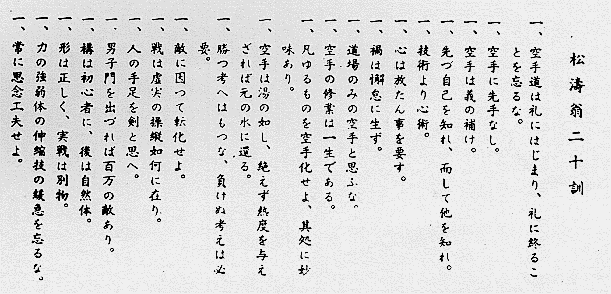Do not forget that karate-do begins and ends with rei
空手道は礼に始まり礼に終る事を忘るな

This is the first in a series of posts to examine Shotokan’s niju kun, Gichin Funakoshi’s list of 20 guiding principles for karate.

The first principle is:
空手道は礼に始まり礼に終る事を忘るな
In Romaji:
Karate-dō wa rei ni hajimari rei ni owaru koto o wasuruna
In English, I think the best translation is:
Do not forget that karate-do begins and ends with rei.
The striking thing about this translation is that it leaves “rei” untranslated. We’ll come back in a moment, but first let’s break this precept down into its constituent parts. There are three things going on here:
- The “Never forget” part.
- The “begins and ends” part.
- The “rei” part.
Let’s look at them in reverse order.
Rei
It’s tempting to try to translate “rei” as “courtesy”, “respect”, or even “bowing”, but these all fail to capture the totality of rei as Funakoshi intends it here. The reason it’s often translated that way is clear. When given the command “Rei”, we bow. Bowing is a physical expression of courtesy, implying respect. All of those are part of rei, but none of them is rei.
To understand rei better, let’s contrast its use here with the fourth precept of the dojo kun, “礼儀を重んずること” or “reigi o omonzuru koto.” Notice here it’s not “rei” (礼), it’s “reigi” (礼儀). What’s the difference?
“Rei” (礼) is the overarching concept of respect for oneself and others, and “gi” (儀) means “ritual” or “ceremony”, so “reigi” (礼儀) means “the ceremonies having to do with respect.” In other words, “reigi” is how you conduct yourself in order to show respect, not the respect, itself.
In case you think that’s just splitting hairs, remember that Funakoshi was a poet, author, and schoolteacher who chose his words carefully. He chose to go to print with “rei” in one place and “reigi” in another, and I choose to believe it was deliberate. Funakoshi is talking about the overarching concept of respect for self and others, not just the outward signs of respect.
Furthermore, I think it’s critical to understand the bidirectional and reflexive nature of rei. In English, we often say “respect goes both ways”, meaning both parties should respect each other. While that’s also true here, rei puts value on self-respect too. Giving someone your respect is meaningless if you don’t believe your respect is something worth having in the first place.
Begins and Ends
It would have been simple for Funakoshi to say, “Karate is all about rei”, but he didn’t. He said it “begins and ends with rei.” Why? Well, … if it begins and ends with rei, then what about the part in the middle?
With apologies to Thomas Hobbes, the actual performance of karate should be “nasty, brutish, and short.” The goal is to end the threat as quickly and efficiently as possible so we avoid injury and get some safely. If, in so doing, we have to harm our attacker, so be it.
But being able to do harm isn’t enough. When justified, we must also be willing. That’s much harder to practice, but that’s what I think Funakoshi is getting at with the “begins and ends with” part of this precept. He’s saying we must have genuine respect for our opponent before we use our skills, and again afterwards, but if a physical confrontation is unavoidable, we must be able to “flip the monster switch” until it’s over.
Never Forget
It’d be easy to treat the “never forget” part as a throwaway, but it isn’t. Funakoshi included it because it’s easy to forget, especially in the heat of the moment.
- When someone blasts you in the face during sparring.
- When you don’t pass a test but someone else did.
- When you’re out with your friends and some guy gets up in your face.
- When a student keeps horsing around while you’re trying to teach. 😉
In all of these situations, it’s easy to forget that karate begins and ends with rei, but we have an obligation to practice rei, particularly if we’re trying to set an example for others.
What’s so important about rei?
Now we understand all the pieces, but what’s so important about rei in the first place? Furthermore, even though all twenty precepts of the niju kun begin with “Hitotsu”, implying equal importance, why does this one come first?
Rei is a differentiator. It’s a boundary - a line in the sand separating civility from barbarity. Genwa Nakasone wrote that “Fighting technique wthout rei is not a martial art; it is only violence and brutality.” Defending oneself in order to return home safely is compatible with rei. Picking fights and endangering others is not.
So why does it come first? I believe it’s because the other precepts can be learned while training, but this one should be demonstrated before one’s training begins. Karate is a weapon to be shared only with those who are both respectable and respectful.